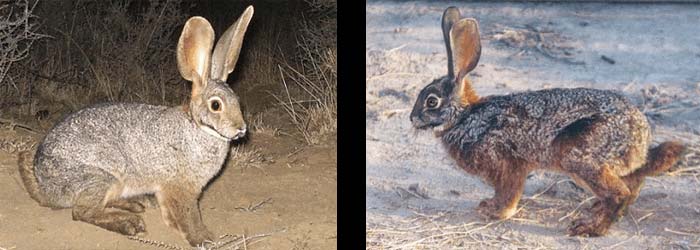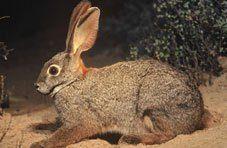The Riverine Rabbit, also known as Bushman’s hare, is endemic to the central Karoo Desert of the Northern and Western Cape. Sadly, it’s also one of the most endangered mammals in the world, with only a few hundred living adults around today.
While it has the general appearance of most rabbits, Bushman’s Hare is recognisable by a dark brown stripe running from the corner of the mouth to the bottom of the ears, and white rings around the eyes which give it a slightly startled look. Cute and rare, these nocturnal animals are rarely seen, even by fieldworkers. It has, however, featured in a 3D South African animated film about a half-striped zebra named Khumba which was born into a herd of all-striped zebras. Being different to everybody else, Khumba was blamed for the drought which has set into the Great Karoo and as the result experienced many adventures. Among a number of colourful individuals which have crossed its way, the ostracised zebra meets the riverine rabbit which has escaped extinction by mastering skills such as impersonations and beat-boxing.

Back to real life… As the name suggest, the Riverine rabbit prefers to occupy river basins and uses the sandy soils for burrowing. Its diet consists of flowers, grasses and leaves, which it will eat during the night. These rabbits produce 2 kinds of droppings, nighttime droppings being hard like pellets, while soft daytime ones are consumed to absorb vitamin B produced by bacteria in the gut. The rabbit spends its days resting under a bush, which is also its way to remain hidden from the predators. When alarmed, it can jump over one meter high bushes to escape the danger.
Males and females normally mix only with the purpose of mating, and each sex maintains home ranges which slightly overlap. This species is polygamous, which means the guys will mate with more than one female. What is unusual for rabbits is that the females of this species give birth to only one (or on rare occasions two) young each year, following a pregnancy period of 35 days. Bearing their young underground is another feature which makes Bushman’s hare different to other African rabbits. Offspring is born bald, blind and immobile, and since this makes them pretty much helpless, mum will make a nest for the baby using grass, fur, soil and twigs, and the young will remain with her for some time before moving on. The Riverine Rabbit rarely lives for more than three years in the wild, and they’ve never been kept in captivity.
Having them classified as critically endangered, many conservation efforts were put in place to stop and reverse an alarming trend of the 60% decline in population over the last 70 years. The main threat and reason for extinction is habitat loss. Since Riverine Rabbits live in riverine area which is perfectly suitable and in high demand for conversion to agriculture, their natural habitat has been ploughed over. Other threats include hunting, natural predators, and dams which dry up the rivers. Add to that the low breeding rate of only one young per year, and it’s clear that unless we invest some serious efforts to help them out, these cute bunnies might not be hopping around the Karoo desert for much longer.




